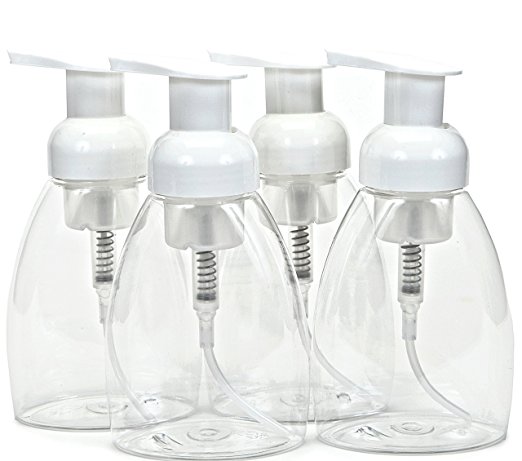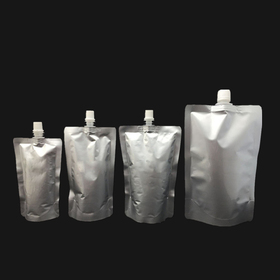Assuming the same lineup of products (shampoo, conditioner, leave-in spray), we could consider some different packaging as part of Project 3.0 … which could help with cost control and enhance marketabilty.
Packaging Ideas For The Shampoo
Basic Concept: have a “permanent” bottle with a foaming dispenser, that gets refilled rather than replaced. The shampoo could be dispensed in 8 oz. foaming dispensers, which could be decorated quite nicely, with the design idea being that these would be “permanent” and not disposable.

One example of a bottle we could get. This one’s too ugly; we’d want a Boston Round, white, to go with the other bottles.
Refills could then be sent in a “spouted pouch” like that shown here (but nicely decorated with our logo and required label information):

The volumes in the pouches could be small (e.g., 8 oz) or up to 32 oz. There are significant cost savings here, both in terms of packaging and in shipping costs. And if the pouches were made from recyclable plastic, we could show even more eco-friendliness.
Packaging Ideas For The Conditioner
The conditioner could be shipped in the existing bottle (with a “lotion pump” cap), or it could be handled with the foaming-dispenser / replacement-pouch concept set forth above. If the latter case is chosen, the viscosity should be lessened so that it can pour more easily out of the pouch and so that it can be easily pumped and aerated in the foaming dispenser cap. One of the benefits of dispensing the conditioner this way is that instructions for distributing the conditioner to the scalp and to the underlayers of the hair would be exactly the same as the shampoo.
Packaging Ideas For The Leave-in Spray

Protect Leave-in Spray
There are two packaging issues to be addressed with respect to the Leave-in Spray:
- First, it would be good if we could avoid having to shake the bottle before use.
- Second, we need to reduce the size (or increase the use-up rate); right now, a bottle of leave-in spray lasts a very, very long time.
Reformulation to Solve The “Shake Well” Problem. If it is possible to prevent the product from separating into two phases (basically, oil and water), then a reformulation to accomplish that would be the best path forward. If that were the case, then the current pump-spray cap on a hand-holdable bottle works fine.
If this were the case, we could offer the user the alternative of 1) buying refills in a “spouted pouch” they’d use to refill the hand-held bottle, or 2) buying replacement bottles directly, presumably with the pouches being slightly less expensive.
Special Packaging To Solve the “Shake Well” Problem. About 2 years ago, I was approached by a packaging specialty firm in Cleveland. During discussions, they suggested we consider a bottle with two internal chambers, one for the water and the other for the active ingredients. The mechanical action of depressing the pump-spray cap would cause the appropriate amount of the active ingredients to be mixed with the water “on the fly.” That way, it was suggested, we could avoid the need to “shake well” before each use and still guarantee that the right amount of product would be applied to the hair.
Obviously, this second idea would take some significant design and custom manufacturing work, but I mention it because it is an alternative.
Reduce the Size and/or Increase the Use-Up Rate. Frankly, the spray lasts too long — 8 ozs (236 ml) can create over 1400 “spritzes”. (There are 6 spritzes per ml; that is, each spritz is 0.17 ml) With the average user only using 3 spritzes, that means an 8 oz. bottle of leave-in spray lasts (236/0.17)/3 or about 466 days (if used daily).
As I think about how packaging can deal with this problem, I only have hypotheses to investigate — no real answers. Realistically, a user will only want to pump 5-8 times at a maximum; so, we could dilute the current formulation 50% (so that it takes 6 spritzes to get the same dose as today’s 3 spritzes). In that case, the bottle of leave-in spray would last 233 days, not 466. That’s still too long. And it will annoy users who have to use more than 3 spritzes of today’s product. (Example: someone who uses 6 spritzes today will need to use 12 spritzes if we dilute the product by 50%.)
Here’s a second thought experiment. If the volume of each “spritz” dispensed could be expanded from today’s 0.17 ml to say 0.25 or 0.33 ml (and I’m not sure this is physically possible), and if the formulation would be diluted by another 50%, then the use-up rate could be increased further, with an 8 oz. bottle lasting 117 days. In this case, the average user would end up with 4 times the water volume on her head (2.0 ml vs. 0.5 ml) but the exact same dose of the oils. Frankly, this would aid in the distribution of the Lipid Complex, but might not acceptable to the user (who now needs to dry her hair) and who may be using more than 3 spritzes today.
The better idea would be to reduce the size of the bottle, perhaps to 4 oz. or 6 oz. At 4 oz., all the numbers set forth above would be cut in half. We will need to conduct a thorough product management and product marketing review of all these trade-offs, but revisions to packaging are likely going to be desirable and maybe necessary when revising products as part of Project 3.0.